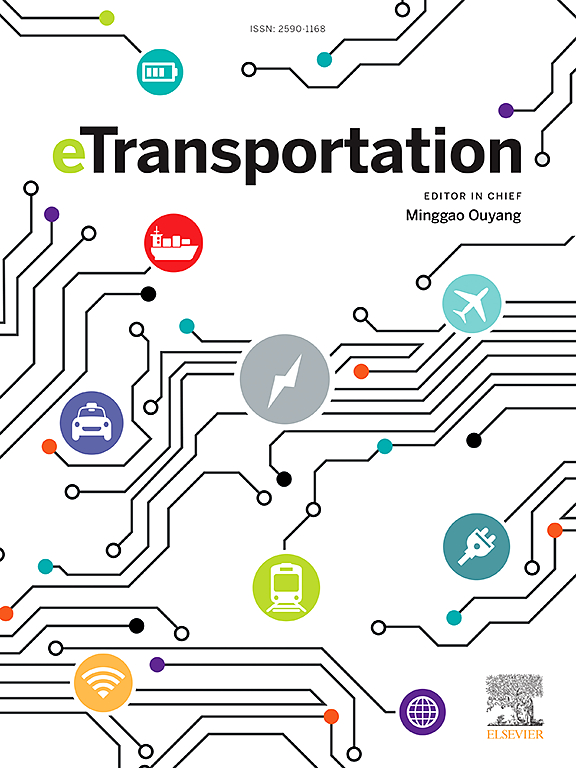利用相变材料改善锂离子电池热状态的最新进展和前景:内部和外部传热增强因素
IF 15
1区 工程技术
Q1 ENERGY & FUELS
引用次数: 0
摘要
电动汽车(EV)在减少燃料消耗和排放方面发挥着至关重要的作用,这凸显了锂离子电池(Li-ion)在为这些车辆提供动力方面的重要性。然而,锂离子电池易受温度波动的影响而出现性能下降、容量损失和灾难性故障,因此必须进行有效的热管理。本综述探讨了基于 PCM 的电池热管理系统 (BTMS) 的进展和挑战,重点关注影响性能的内部和外部因素。它讨论了内部因素,如基于 PCM 的 BTMS 在材料层面的改进,包括基于 SiC 和 EG 的 PCM、柔性复合 PCM 和蛇形 PCM 等解决方案。流体流动动力学、电池间距和形状等外部因素对 BTMS 性能有重大影响。关键的考虑因素包括评估基于空气和液体的方法,以及将热管与 PCM 集成用于被动式 BTMS。此外,了解这些因素对温度均匀性和散热的影响也至关重要。论文最后概述了基于 PCM 的电池热管理的未来趋势,强调在混合 BTMS 配置中使用柔性 PCM 和铜泡沫增强 PCM,以优化性能。通过全面解决内部和外部因素,BTMS 可以提高电动汽车中锂离子电池的效率和寿命。本文章由计算机程序翻译,如有差异,请以英文原文为准。
Recent advances and perspectives in enhancing thermal state of lithium-ion batteries with phase change materials: Internal and external heat transfer enhancement factors
Electric vehicles (EVs) play a crucial role in reducing fuel consumption and emissions, underscoring the importance of lithium-ion batteries (Li-ion) in powering these vehicles. However, Li-ion batteries are susceptible to degradation, capacity loss, and catastrophic failure due to temperature fluctuations, necessitating efficient thermal management. This review explores advancements and challenges in PCM-based battery thermal management systems (BTMS), focusing on internal and external factors influencing performance. It discusses internal factors such as material-level improvements in PCM-based BTMS, including solutions like SiC and EG-based PCM, flexible composite PCM, and serpentine-shaped PCM. External factors, such as fluid flow dynamics, cell spacing, and shape, significantly influence BTMS performance. Critical considerations include evaluating air- and liquid-based approaches and integrating heat pipes with PCM for passive BTMS. Furthermore, understanding the influence of these factors on temperature uniformity and heat dissipation is essential. The paper concludes by outlining future trends in PCM-based battery thermal management, emphasizing the utilization of flexible PCM and copper foam-enhanced PCM alongside hybrid BTMS configurations to optimize performance. By comprehensively addressing internal and external factors, BTMS can enhance Li-ion battery efficiency and lifespan in EVs.
求助全文
通过发布文献求助,成功后即可免费获取论文全文。
去求助
来源期刊

Etransportation
Engineering-Automotive Engineering
CiteScore
19.80
自引率
12.60%
发文量
57
审稿时长
39 days
期刊介绍:
eTransportation is a scholarly journal that aims to advance knowledge in the field of electric transportation. It focuses on all modes of transportation that utilize electricity as their primary source of energy, including electric vehicles, trains, ships, and aircraft. The journal covers all stages of research, development, and testing of new technologies, systems, and devices related to electrical transportation.
The journal welcomes the use of simulation and analysis tools at the system, transport, or device level. Its primary emphasis is on the study of the electrical and electronic aspects of transportation systems. However, it also considers research on mechanical parts or subsystems of vehicles if there is a clear interaction with electrical or electronic equipment.
Please note that this journal excludes other aspects such as sociological, political, regulatory, or environmental factors from its scope.
 求助内容:
求助内容: 应助结果提醒方式:
应助结果提醒方式:


